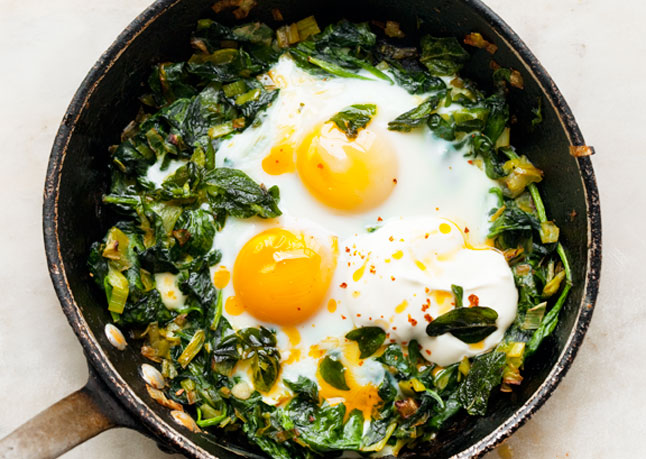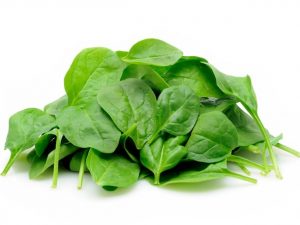
You know when you have one of those days where there are a lot of coincidences? I had one of those a few weeks ago and it all started with reheating spinach.
First time lucky
My colleague was eating spinach in a quiche for lunch, but it was a bit too much for her to finish. She said she’d better throw it out because you can’t reheat spinach.
What?! I was curious, what did she mean?
She said that in the Netherlands they have been told not to reheat cooked spinach. I had never heard that before. 
Later that day, a Polish colleague sent me an email and said she heard you shouldn’t reheat spinach and she wondered what I thought of that. In the evening my flatmate said a similar thing.
I thought, ‘I have to find out what this is all about?’ and started doing some research.
I’ve lived in several different countries and everywhere I’ve gone I’ve discovered interesting culinary ‘rules’ that usually originates from a health scare.
When we eat food that has travelled many miles or is produced in poor sanitary conditions we expose ourselves to risk. With diets high in sugar and processed foods that are nutrient-poor, our immune systems struggle to fight exposure to the bacteria and other organisms that we may be exposed to.
Salmonella
Growing up in Canada we were told to cook our chicken well and to store eggs in the fridge. Never use a wooden chopping board for chicken or allow any raw chicken to touch other foods. This is all sound advice as the majority of food poisoning occurs in the home, but are we being too particular?
When I moved to the UK and went to the grocery store – gasp! – they had their eggs on the shelves, and not in the refrigerator. Didn’t they realise they could get salmonella poisoning? I travelled around Europe; the French, the Germans and the Dutch all keep their eggs out of the fridge. What is going on? Could it be that salmonella wasn’t such a big risk? Why are Canadians so fearful of salmonella?
The facts:
- 6,700 cases of salmonella-related illness in Canada each year
- 800 of these result in hospitalisations
- three to five deaths annually
Salmonella is obviously a problem, but why don’t people in Europe worry as much as Canadians? Do they have stricter standards?
Chlorine on our eggs?
What I found out is that in North America (Canada and the US), we wash our eggs. Due to the overcrowding of some concentrated animal feeding operations (CAFO’s), the animal’s immunity is lower and eggs are exposed to more contaminants due to the lack of sanitation and access to a normal, healthy life. As a result, and instead of improving the conditions, the eggs are washed; but not just with a bit of soap and water.
As the eggs are scrubbed, rinsed, dried, and spritzed with a chlorine mist, its protective cuticle may be compromised. This is a natural barrier that comes from the mother hen that lays the egg, and it acts as a shield against bacteria. The exposure in the CAFO’s to salmonella is much higher than in non-CAFO farms.
The pointhere, is that often these things come out of a health scare. They should be taken seriously, but we should also understand why and question what we have been told.
The answer to the spinach question
So, what I knew about spinach was that it contains nitrates, as do other leafy green vegetables as well as radishes, eggplants, celery, cured meats and some water supplies. What I found was that nitrates can break down to form nitrites from the organisms that are present on these foods. Nitrites can lead to methemoglobinemia, where the uptake of oxygen in the blood is adversely affected. In babies this is called Blue Baby Syndrome.
Nitrites can also convert into nitrosamines, if not enough antioxidants are present in the body. Nitrosamines are a known carcinogen (cancer-causing agent). This is the reason cured pork (bacon, sausages) are also sprayed with ascorbic acid (vitamin C).
So, while it’s a good idea to follow advice on food safety in your own country, it’s an even better idea to understand why. Spinach is loaded with vitamins (A, C, K, Folate) and minerals (calcium, magnesium) and can be a part of a healthy diet. How do you manage it in a healthy and save way?
Enjoy your spinach safely
- If you can’t finish your spinach and want to save it for the next day, be sure to cool it quickly and keep it below 5 degrees celsius to prevent nitrite production
- Eat lots of foods with antioxidants to prevent nitrites converting into nitrosamines; good examples are dark coloured fruits and vegetables
- Buy organic spinach to avoid the fertilisers and pesticides that spinach absorbs (which contain nitrates)
- If you have a thyroid (or adrenal) issue you should always steam your spinach to deactivate the goitrogens, which can prevent the uptake of iodine
References:
Nitrates, Nitrites and Nitrosamines by IA Wolff and AE Wasserman


Comments
[…] say act cautiously! When possible, eat spinach fresh and uncooked. If you decide to use spinach in a cooked recipe, […]
[…] οργανισμών. Τα νιτρώδη μπορεί να επηρεάσουν το επίπεδο του οξυγόνου στο αίμα, γίνονται τοξικά και μπορεί να προκαλέσουν τροφική […]
[…] which can break down and form nitrites due to organisms that are present. Nitrites can affect the oxygen level in the blood, become toxic and cause food poisoning when […]
Several months ago I had left some cooked spinach out overnight. Little did I know what I was in for, when I reheated (it was spinach after all) it and ate the whole bowl. Within 2 hours I was throwing up. I was sick for the next 3 WEEKS. I had no idea it could make me sick. I threw up for two weeks. Off and on the 2nd week. Thought I was getting better, only to get sick again. I should have went to the hospital. I even had vision problems for several weeks after. Never reheat spinach that has been left at room temperature (NEVER, NEVER)
Thanks for sharing your story Susan. It would have been good to have gone to the hospital so they could test you and see what the problem was. It’s unclear whether it was the spinach as we can sometimes react to foods up to 72 hours after ingesting them if it’s an allergic reaction. It is always good to be cautious, but as we know from the recent Listeria outbreaks, there can be contamination with fresh vegetables. Usually these outbreaks are not isolated to one person and it is always important to report to your doctor when you feel ill like this as they may then test you and report it for statistics and public awareness.
Yes, I realize the hospital would have been a good idea. I got sick within two or three hours of eating the spinach. It had been left out overnight and into the afternoon. I had eaten nothing prior that day, had run lots of errands and was extremely hungry, hence eating left out spinach. I have had food poisoning before, more than once. It usually comes on quick, and fierce, as this did.
Hmm…I just defrosted a brick of frozen chopped spinach in the microwave to use in a recipe, and put the remainder in a bowl in the fridge to maybe use in something else. Microwaves and frozen bricks of spinach being what they are, some parts of the spinach were much hotter than others as I was trying to break it up to stir into the sauce I was making. Since the unused portion went into the fridge right away, should it still be pretty okay for tomorrow?
Hi Emily,
I can’t really comment on each individual situation, but you can apply the principles I wrote about in the article. If you put it into the fridge straight away I would think it’s probably fine, but it’s up to you.